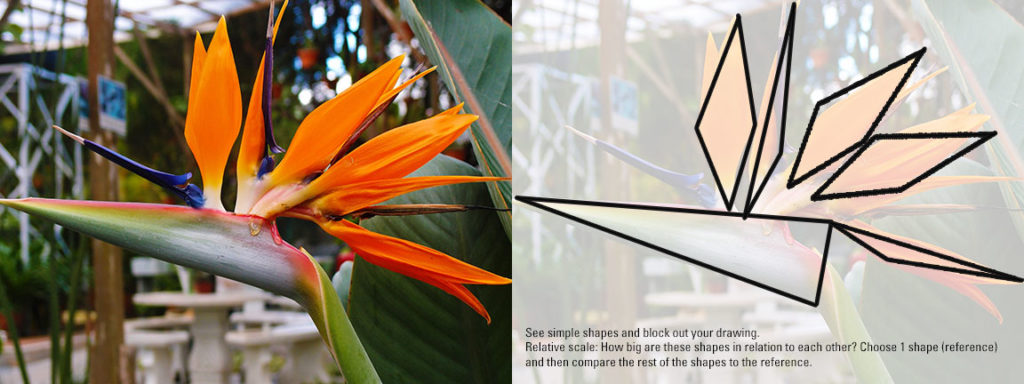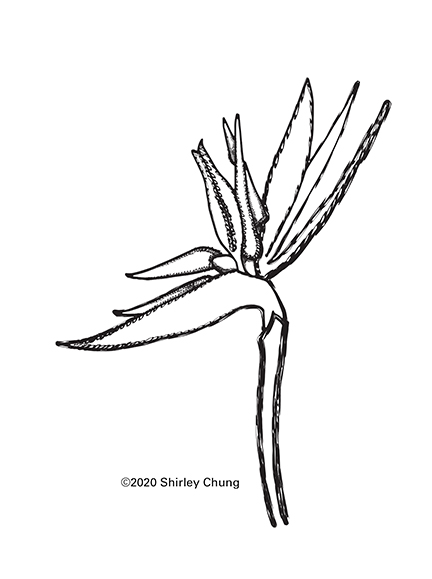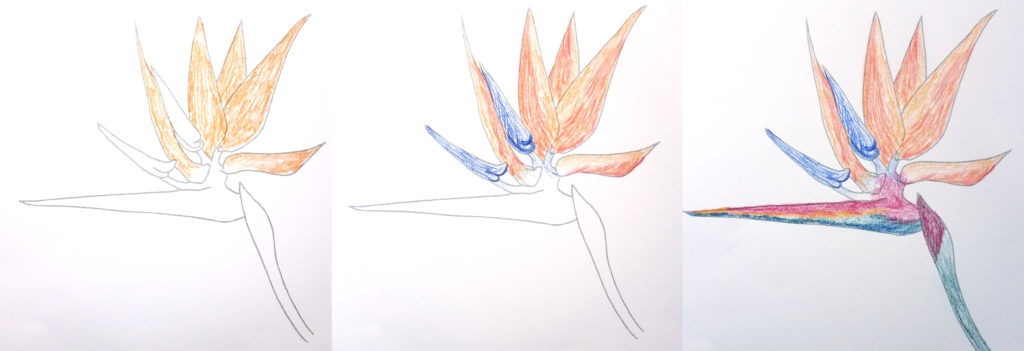Introduction
Bird of Paradise (Plantae, Magnoliophyta, Liliopsida, Zingiberales, Strelitziaceae, Strelitzia).
One of the most beautiful and exotic flowering (late winter to early spring) tropical plants is the Bird of Paradise (BP), Strelitzia. There are different varieties such as the orange BP (Strelitzia reginae) and white BP (Strelitzia nicolai). Interestingly, BP is a relative to the banana plant. The BP plant grow a lot larger than most photographs show–leaves 12-18 inches which emerge from the soil (trunkless) and around 5-7 feet tall (plan for at least 8’x8′ diameter of space). You can start these plants indoors, and move them outside if needed. They like at least 6-7 hours of bright sun, heat and humidity (moist well-drained soil, not waterlogged) of a tropical climate. It takes 4-5 years for the plants to mature (keep it contained, root-drained) before they will flower–an exquisite display! This is a rhizome plant and as it ages you can divide the rhizome to repopulate. However, if you divide the rhizome, it could set back the flowering (because it will take energy for them to reestablish themselves in a new pot). Definitely see some of the references and videos.
The Art.
Goto https://pixabay.com/ and do a search for “bird of paradise”. Pixabay is an excellent resource for images and vector art for personal and commercial use. Select a reference photo of the flower such as this one https://pixabay.com/photos/flower-attractions-orange-bloom-4683646/

Block in shapes. Look at what you want to draw. Can you simplify it into basic shapes? Pick one of your shapes to be the reference. How big/small are the other shape in relation to the reference? That will guide you in your drawing. When you start drawing your shapes, use a pencil and a light touch. Don’t go too dark in case you want to erase later.
Download these free PDF templates (free for personal use; please do not resell or repackage for sale).
- Bird of Paradise 1
- Bird of Paradise 2
- Bird of Paradise 3
- Bird of Paradise 4
- Bird of Paradise Composition 1
- Bird of Paradise Composition 2
Transferring the template images. In the following video, I’m going to show you how to make your own transfer paper (you can also buy transfer paper in the stores called carbon or carbonless transfer paper). Remember that when you’re experimenting, use a lighter touch with your pencil. That way, if you want to change something, you can do so more easily.
Scale & Composition. Experiment with different sizes of the templates and try arranging them yourself. You can print the PDF’s smaller by adjusting the PDF/Printer Settings (those are specific to your computer setup).
Line. Be creative with your “outlines”. All the lines do NOT have to be perfect. Try a brush ink marker, or a marker that has a chisel tip (tip can make a thin line and a wide line depending on how you hold it). You can even use darker pencil lines and make it look “doodley” like this example below. There are no rules!!

Borders. Do you ever pay attention to all those greeting cards in stores? Sometimes, a nice border brings in the composition. Experiment with different borders, different thicknesses, different shapes (e.g. rectangular, oval), and creative lines. You may use different free online draw/paint programs and make some super creative borders with leaves.
Background. Experiment with the background. Do not make the background more detailed than the foreground (flowers), because you don’t want to take the focus away from the flowers. Don’t make the background colors too contrasty. Try subtle different shades of green, blue, or perhaps a muted/duller color that is less vibrant than the flowers. You can also just leave the background a solid color if you want. You can use a gradation/ombre from light to dark in the background. Play around. Look at examples the next time you go shopping for greeting cards. Look at examples online.
Color. This is the fun part! Personally, I like to find an online photo of the flower and use that as my guide. These flowers have a few different species which have some color variations. Since the color is really makes this flowers recognizable as well as the unique shape of Bird of Paradise, I like to block in some of the same colors as in the photo. Later on, I’ll introduce different types of media for coloring (e.g. color pencil, water color paints, acrylic, pastel, etc.). For now, let’s keep it simple with either crayon or color pencils.

References
- https://www.thespruce.com/how-to-grow-strelitzia-1902742
- https://greeneryunlimited.co/blogs/plant-care/bird-of-paradise-care
- https://www.gardeningknowhow.com/ornamental/flowers/bop/bird-of-paradise-an-exotic-flower-like-none-other.htm
- https://www.joyusgarden.com/bird-paradise-plant-care/
- https://youtu.be/NYSKhN2DkQc
- https://www.theflowerexpert.com/content/aboutflowers/exoticflowers/birds-of-paradise